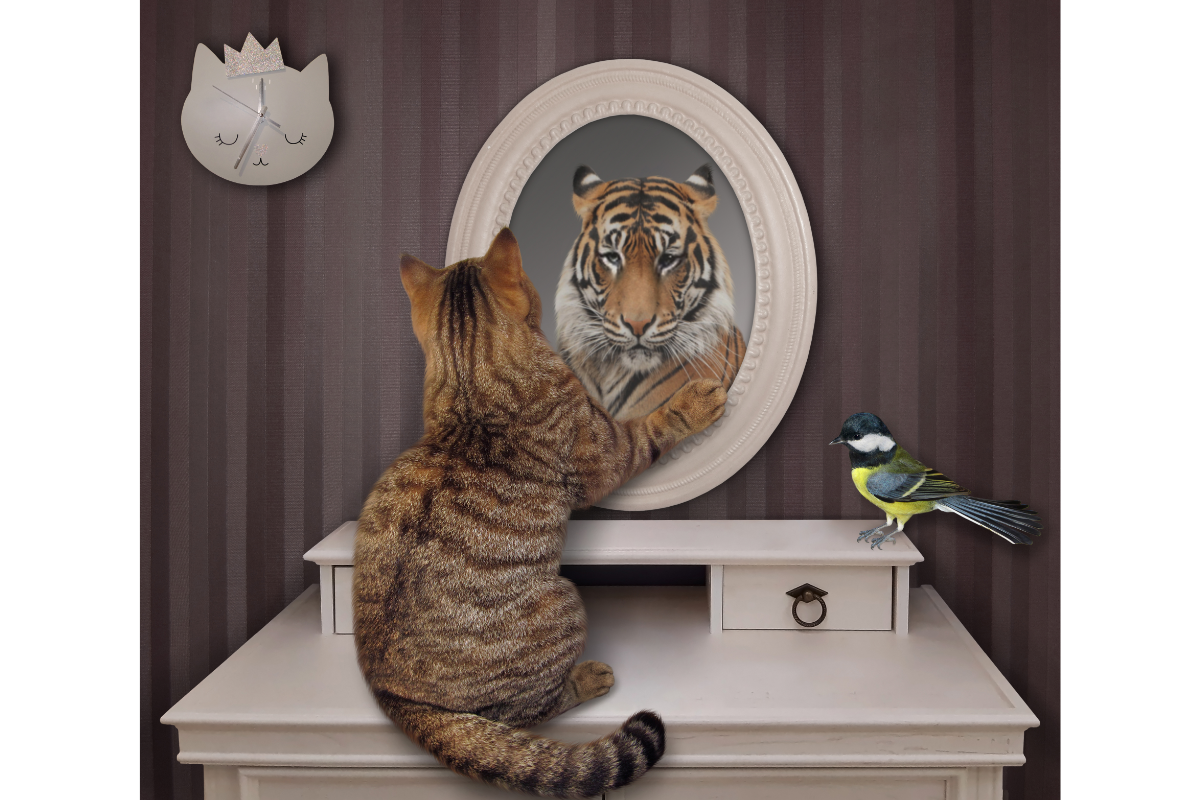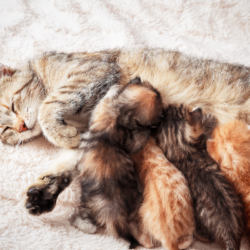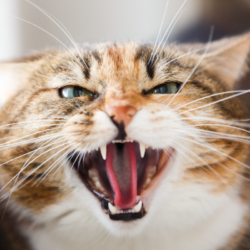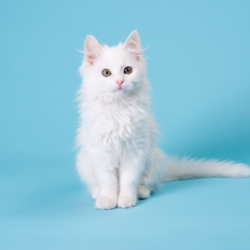In the vast world of feline behaviour, certain disorders remain shrouded in mystery and conjecture, such as Tiger Syndrome in cats. This condition, which arouses both curiosity and concern among pet owners, manifests itself in sudden episodes of aggression that are often incomprehensible and difficult to predict.
What is Tiger Syndrome?
If your cat is hiding from you, jumping on you and biting you, it could be Tiger Syndrome, an atypical form of aggressive behaviour. Tiger syndrome is characterised by sudden and extreme aggression. The cat seems to lose all control and attacks those around it. Its intensity evokes similarities with rabies.
This phenomenon can affect all cats, including those with a normally gentle and affectionate temperament. This is why this disorder represents a potential danger for the owner. The owner could be caught off guard and injured. During an episode of this syndrome, the cat becomes an aggressive predator, using claws and teeth. These attacks can transmit bacteria and have serious consequences for those affected. It is therefore crucial to recognise this behaviour and treat it appropriately.
Tiger syndrome manifests unpredictable violence. It suddenly transforms the familiar cat into a potential danger to itself and those around it. Symptoms include sudden attacks, with scratching, biting and aggressive behaviour such as feinting, specifically targeting the legs or face, and can occur even during everyday actions such as distributing food.
This aggression is generally attributed to dietary problems, such as inadequate or deficient nutrition, causing hunger that triggers aggression. However, a cat’s aggression can have many origins: hunger, irritation, fear, stress, or other. When faced with such behaviour, it is absolutely essential to act with caution and protect those present. In fact, this is a temporary state in which the cat reveals a predatory instinct linked to its wild heritage.
What causes it?
The causes of tiger syndrome in cats are multiple and complex, involving a variety of factors that differ from one individual to another. Among these factors, diet plays a crucial role. An imbalance, whether in the quantity of food or the way it is distributed, can lead to frustration and aggression in cats. The common practice of serving one or two large meals a day contrasts sharply with the natural needs of cats, who are instinctively inclined to eat several small meals throughout the day. This discrepancy can be a factor in triggering the syndrome.
Lack of activity is also a major factor, giving rise to tension and nervousness that can lead to episodes of aggression. Similarly, fear of a hopeless situation can turn a cat into an extremely aggressive creature.
Irritation, provoked by inappropriate interactions such as rough play or unpleasant handling (such as nail clipping, bathing or veterinary visits), can lead to violent reactions if the cat has been holding in its discontent for a long time.
Stress, whether occasional or chronic, is a significant trigger for aggression. Play can also play a role when it generates frustration or extreme excitement, potentially leading to true tiger syndrome.
Ultimately, while diet is often cited as the main cause, tiger syndrome in cats results from a combination of lifestyle factors, including stress, fear, irritation and lack of activity. These factors, combined with an unsuitable diet, can lead to intense aggressive behaviour. It is therefore essential to identify and treat these factors in order to prevent and effectively manage this problematic behaviour.
How should you react in a crisis?
If your cat suddenly displays extremely aggressive behaviour, here are the steps to follow without resorting to violence:
- Gently push him away to avoid any aggression, acting by reflex or impulse.
- Put him in a separate room to protect the other occupants and animals, until you calm down.
- Consult a vet for a diagnosis, advice on diet and hygiene, and if necessary, a prescription for tranquillisers.
In the event of an acute attack, when the animal seems uncontrollable :
- Get yourself and other people out of the way, avoiding facing the animal so as not to provoke an attack.
- Give it a firm command; if that doesn’t do the trick, try to calm it down gently without endangering it or yourself.
- Put him in a safe place and contact a professional, either a vet to look into the causes of this behaviour or a cat behaviour expert.
Once the cat has calmed down and seems receptive, you can reassure it by stroking it. After all, his behaviour was impulsive and uncontrolled. Avoid late, unnecessary and counter-productive punishments, as the cat cannot associate the punishment with its previous behaviour. You run the risk of creating a misunderstanding and potentially a new crisis.
What can you do about it?
Tiger syndrome remains a complex disorder with no established medical treatment. However, if your cat has this disorder, a discussion with your vet is crucial to identify whether it really is tiger syndrome or another behavioural cause. If it is confirmed, identifying the trigger for the attacks is essential.
Start by assessing the diet: discuss with the vet the types of kibble, quantities and methods of distribution. For owners who are away during the day, a kibble dispenser that allows frequent meals can reduce boredom and respect the cat’s natural feeding rhythm.
To combat boredom, we recommend physical and mental activity. Playing with your cat strengthens your bond and provides a healthy outlet. If the play becomes too intense, redirect his attention to a toy. Arrange the space with stimulating features such as cat trees, hammocks or swings to encourage activity and limit boredom. Routine is also vital to your cat’s well-being, so set up routines that he can stick to.
If in doubt, or for a personalised approach, consult a behavioural veterinarian. Changes to diet, time for play and tranquillity, elimination of stress, and sometimes medication may be necessary.
Eco-ethological intervention, adjusting the cat’s living environment to the needs of its species, can help. This includes self-service feeding, environmental enrichment, and the use of play dispensers to stimulate the predatory instinct in a positive way. In some cases, psychotropic drugs such as fluoxetine are prescribed to reduce aggression and adjust food intake.
How can this disorder be prevented?
Preventing tiger syndrome involves making adjustments to your cat’s environment and lifestyle, including :
- Food management: Ensure sufficient food in quality and quantity, distributed in several small meals throughout the day to mimic natural predatory behaviour.
- Stimulating lifestyle: If outdoor access is impossible, enrich the indoor environment to encourage exercise. Placing bowls high up can encourage your cat to exercise.
- Limiting negative emotions: Minimise stress, fear and irritation, all of which are likely to trigger the syndrome. If you can’t avoid stressful situations, give your cat time to recover emotionally. Establish and stick to a daily routine to limit stress.
- Playtime: Give your cat regular opportunities to play. These interactions satisfy its predatory instinct and help reduce frustration. However, be sure to maintain limits during these games to avoid any aggressive outbursts.
These measures, based on a suitable diet, an enriching environment, stress reduction and encouragement to play, are fundamental to preventing the onset of tiger syndrome while promoting your cat’s well-being and behavioural balance.
Coping with aggression naturally
If a modified diet is not enough to improve your cat’s behaviour, medicated treatments, prescribed by a vet, may be considered, including the use of specific cat tranquillisers. To soothe animals suffering from tiger syndrome, natural tranquilisers such as CBD, passionflower, chamomile, hops and valerian can be effective. These natural solutions offer a gentle alternative to drug treatments. Soothing pheromone diffusers and the use of Bach flowers are another recommended option.
CBD oil is particularly well-known for its beneficial effects on animal anxiety. With its relaxing properties, it helps relieve behavioural problems and is a natural, safe solution that can be administered easily by sublingual route.
Food supplements are also recommended for naturally calming agitated states. Plant extracts (passionflower, hawthorn, griffonia, for example) combined with essential nutrients (magnesium and vitamin B6) help to balance neurotransmitters and support the behavioural and emotional well-being of dogs and cats. However, it’s important to be wary of essential oils, which are potentially harmful to cats.
CBD
Although promoted by some brands as a miracle solution,CBD oil does not cure cancer or other serious illnesses in animals. Its use, recommended by vets and users to relieve certain ailments in cats, should be considered with caution and in consultation with a professional to determine its usefulness and appropriate dosage.
To relieve stress,CBD oil has been tested by vets as a complement to medicinal treatment. It has been shown to have relaxing effects. It also appears to improve animals’ sleep. This molecule influences the release of corticosterone, which is linked to memory and fears, suggesting its potential use in managing anxiety and improving quality of life.
A three-week to one-month course of treatment is recommended for optimum efficacy, with sublingual application to prevent indigestion. It is advisable to choose an organic, non-GMO CBD oil specifically designed for animals. Dosage depends on the animal’s weight, starting with one or two drops for the first few days and gradually increasing to the recommended amount. This gradual approach ensures that your cat adapts to CBD, maximising the benefits while avoiding side effects.
Passionflower
Native to South America, passionflower is also known as passion flower. It was named after the Jesuits. It is valued for its anti-anxiety and sleep-inducing properties. The Aztecs already recognised the virtues of passion flower, which they shared with the Jesuits. The Christian symbolism attributed to its healing properties and the splendour of its flowers captivated the Europeans. They introduced it to Europe in the 17th century.
Today, passionflower remains a highly prized natural remedy, particularly for its impact on mood disorders and depression. It is renowned for its soothing effects on both humans and cats, and is used in phytotherapy for the calming molecules present in its leaves and flowers.
The Aztecs used it both in cooking and as a remedy for anxiety and heart problems. Its ability to relieve a variety of ailments has been recognised by scientific committees, notably for :
- Anxiety
- Neuralgic pain
- Muscle pain and spasms
- Digestive problems
- Sleep disorders
Passionflower is often combined with valerian. They form a duo of plants that act synergistically to enhance their soothing effect.
The magnesium / vitamin B6 combination
Magnesium and vitamin B6 are commonly found in food supplements designed to combat stress, fatigue and nervousness in humans. Their role in nervous balance is crucial, thanks to their ability to inhibit the release of stress hormones. This synergy is also beneficial for cats. This is why these nutrients are increasingly being incorporated into feline anti-stress food supplements, in combination with other substances.
Considered a natural neuroprotector, magnesium plays a vital role in nerve transmission and neuromuscular conduction. It protects neuronal cells against excessive excitation, which can lead to their destruction. It is therefore useful in the management of chronic pain,anxiety and depression.
In stressful situations, magnesium contributes to muscle relaxation. It also helps to combat stress-induced sleep disorders. A magnesium-based supplement can help your pet to manage anxiety in a more balanced way. What’s more, magnesium can improve mood balance. So if you suspect your pet’s mood is low, increasing its magnesium intake could improve its well-being.
An under-researched syndrome…
The concept of tiger syndrome is controversial and raises a number of unresolved issues:
- Lack of scientific basis: There are no scientific studies validating the existence of this syndrome. No recognised specialist has examined it in depth, as it is thought to be the equivalent of rabies syndrome in dogs.
- Inappropriate interventions: In an attempt to help their cat, some owners modify the diet and increase portions. This can further upset the animal’s emotional and physical balance. These changes can lead to new behavioural and health problems, such as obesity.
- Worsening behaviour: Without any visible improvement, these actions complicate the situation, making the cat more difficult to manage. Owners’ despair or resentment sometimes leads to tragic outcomes, such as abandonment or euthanasia.
- Incorrect generalisation: The expression “tiger syndrome” indiscriminately groups together various types of feline aggression. However, each has its own causes and motivations, often far removed from the food issue alone.
- Lack of international recognition: This term seems to be specific to France. International experts, such as Joël Dehasse, Veterinary Behaviourist in Brussels and the Behaviourist Educator in Canada, do not recognise the term. This reflects a lack of understanding of this classification of aggression in cats.
In short, tiger syndrome lacks recognition and scientific proof. What’s more, owners’ reactions based on this hypothesis may make the situation worse rather than better. This underlines the importance of evidence-based approaches to treating aggressive behaviour in cats.





